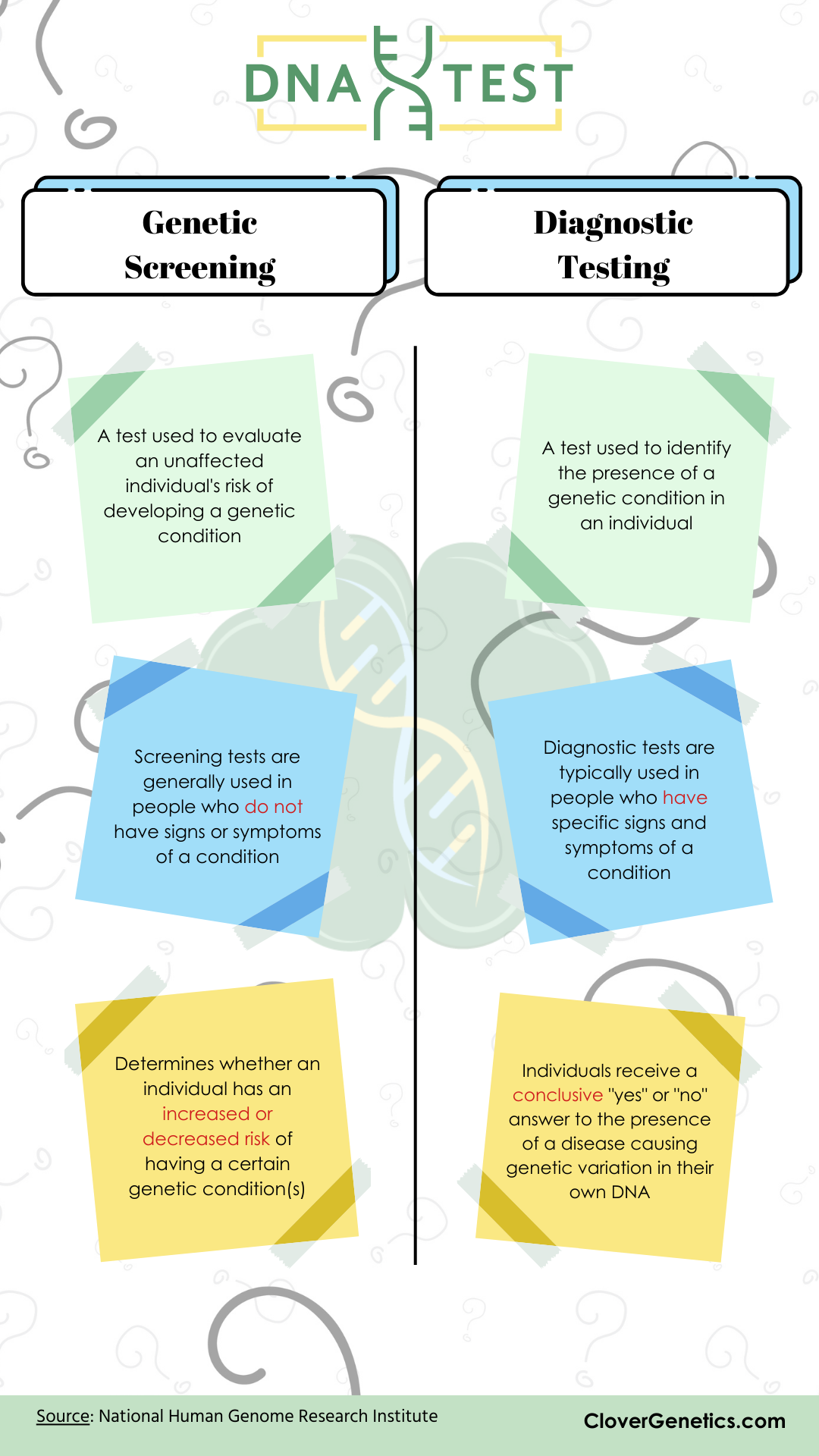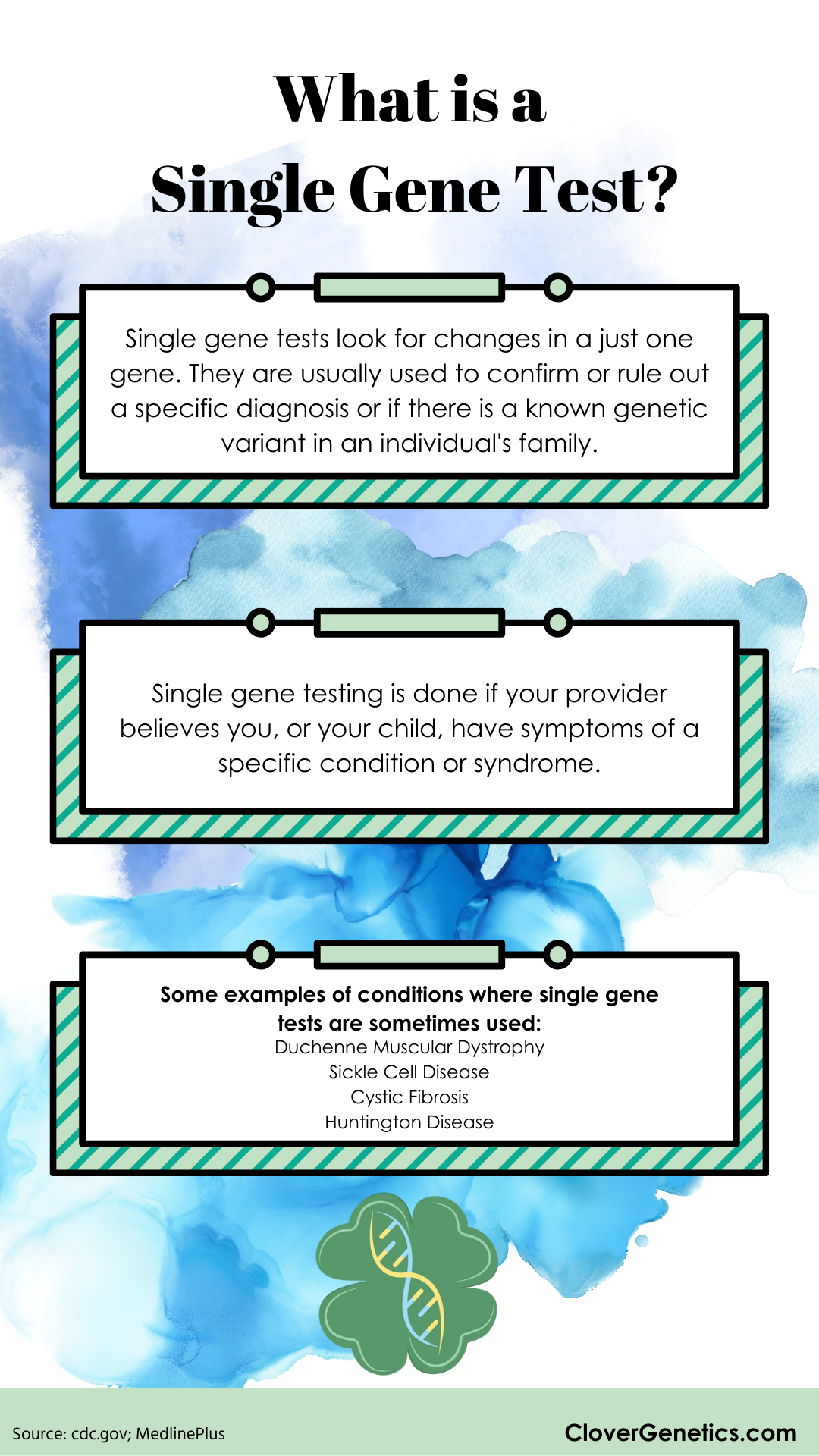Types of Genetic Testing
Page Contents:
What is the Difference between Direct-to-Consumer and Clinical Genetic Testing?
The Difference Between Screening and Testing
Targeted Testing
Clinical Suspicion Testing
Learn More and Citations
What is the difference between Direct-to-Consumer and Clinical Genetic Testing?
There are many ways that genetic testing can be performed depending on what type of information is desired. When an individual does an ancestry DNA test from a kit that can be purchased over-the-counter, like 23&me or Ancestry DNA, they are having only small snippets of their DNA reviewed and analyzed by technology that is not meant for in-depth analysis to identify specific genetic conditions and disorders, but rather to identify someone’s ancestral ethnicity. Those tests fall under the category of “Direct-to-Consumer (DTC)” tests and are not considered clinical, or medically confirmed, test results.
When an individual is seeking medical information about their genetics, like their risk having or carrying certain genetic conditions, their genetically influenced metabolism of certain drugs, or to identify genetic risk factors, then they must undergo clinical genetic testing, either for a specific condition, or a broad screening of a region of their DNA, or even having all sequenceable DNA reviewed through a Whole Genome Screening.
TL;DR:
The main difference between DTC genetic testing and clinically validated genetic testing is that most DTC testing is not accurate enough to gain a true picture of a person’s genetic health and risk factors. Additionally, clinical testing is generally reviewed by many specialists, including genetic counselors, and physicians who can connect an individual’s personal symptoms with their results to identify possible causes (2).
The Difference Between Screening and Testing
Whenever genetic testing is performed, it is critical that the order is correctly placed in partnership with a genetic counselor to ensure that the specific type of testing selected is the best option for determining a patient’s diagnosis or ruling out other conditions.
Targeted Testing vs Clinical Suspicion
Targeted Testing: An individual can be tested for a specific genetic change when a known genetic variant has been identified in a family member.
Clinical Suspicion: If there is no genetic information available (no previous testing), a clinician may choose to sequence a single gene, panel of genes, or even the entire genome to identify possible genetic causes of symptoms (2).
Targeted Testing
Genes are the sequences of DNA that encode for the proteins required for an organism’s survival.
Single-Site Analysis: Looking at a specific location within a specific gene. Typically done when there is a known familial variation or expected pathogenic variant within that gene (2).
Multiple Site Analysis: Looking at multiple specific locations within a specific gene, but not at the full gene
Example: Identifies BRCA variants known to cause cancer in all individuals and screens for other disease-causing variants within BRCA including those most often found in those with Ashkenazi Jewish ancestry (2).
Full Gene Sequence: The entire gene is analyzed for possible disease causing variants within (2).
Clinical Suspicion Testing
Multiple Site Analysis within Multiple Genes: typically only utilized during non-directed carrier screening to review various regions known to cause recessive diseases (2).
Full Gene Sequence of Multiple Genes (A gene panel): collection of genes that have been grouped for testing as they are all implicated in causing a specific disease or phenotype. Usually done with next-generation sequencing (NGS)(2).
Cytogenetics Testing:
See Cytogenetics Page for more detailCopy Number Analysis
Chromosome Analysis/Karyotyping
Epigenetic Studies
Microarray
Exome Sequencing: The exome includes protein-coding genes and their surroundings; about 2% of the entire genome. The remaining 98% of DNA does not encode for proteins. This includes the DNA that provides the instructions for how our bodies grow, develop, and maintain themselves. These sequences code for the proteins required for human function (3).
Whole Genome Sequencing (WGS): Analyzing all of an organism's genetic information, including mitochondrial DNA. Naturally, this includes our genes, but the genome also includes DNA sequences that do NOT produce proteins. This is called non-coding DNA and rather than encode for proteins, they primarily function to regulate surrounding genes. There are some genetic conditions that cannot be detected through WGS and require more specific testing (ex: Triplet Repeat Disorders)(4).
The Exome includes an organism’s genes and surrounding DNA.
The Genome includes all genes, and the DNA between genes, on the chromosomes, and within the mitochondria.
To Learn More:
Page researched and written by: Rachel Wu, Rachel Baer, MSc; Reviewed by Andy McCarty, MS, LCGC, and Amber Schreiber; Graphics by Nira Johnson, MS, GC and Megan Lew
Citations:
Bellagambi, F. G., et al. (2020, March). Saliva Sampling: Methods and devices. An overview. TrAC Trends in Analytical Chemistry 124. https://doi.org/10.1016/j.trac.2019.115781
N.A. (n.d.). “What are the different types of genetic tests?” Medline Plus. https://medlineplus.gov/genetics/understanding/testing/types/
N.A. (n.d.). “Whole Exome Sequencing” Yale Medicine. https://www.yalemedicine.org/conditions/exome-sequencing
Brown, T. A. (2002). “Understanding a Genome Sequence” Genomes, 2nd Edition. Oxford Press. https://www.ncbi.nlm.nih.gov/books/NBK21136/






